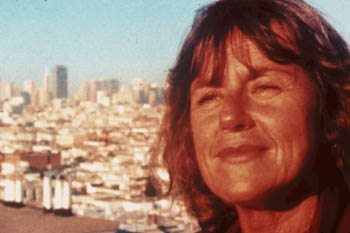![[Metroactive Movies]](/movies/gifs/movies468.gif)
[ Movies Index | Show Times | Silicon Valley | Metroactive Home | Archives ]
Weathered
'The Weather Underground' looks back at the radical movement of the '70s
By Richard von Busack
TODAY, the Weathermen are extinct, a nostalgia item like the Dylan song that they took their name from, "Subterranean Homesick Blues." San Francisco-based documentary makers Sam Green and Bill Siegel's The Weather Underground provides a balanced but sympathetic account of the revolutionaries. Today, some Weathermen are doubt-stricken and sorrowful, but some still refuse to renounce the more than a dozen bombings they committed during the 1970s. Siegel and Green interview Naomi Jaffe, Mark Rudd, Laura Whitehorn and Bill Flanagan, as well as the one member convicted to serious time: David Gilbert, still serving 75 years in Attica for killing a policeman during an armored-car robbery. Speaking out here is the charismatic husband-and-wife team of Mark Rudd and Bernadine Dohrn. Dohrn was "The La Passionata of the lunatic left," blurbed J. Edgar Hoover, then director of the FBI; the crush-worthy Dohrn may well replace Patty Hearst in the hearts of today's rebel fans.
The Weather Underground spun off from the antiwar and pro-racial equality SDS in 1969. More than anything else, they were political vandals who bombed evacuated banks and government offices. Some of the group's paranoia was justified by extremes of the law. Green and Siegel recall the Cointelpro program that harried Martin Luther King Jr. The documentary also touches on the murder by Chicago police of Black Panther Fred Hampton: shot to death, it would seem, for resisting arrest by sleeping. In the background is the ever-more-brutal war in Vietnam.
After the war was over in 1975, the Weathermen redoubled their efforts after losing their aim: one late assault by the cadre was blowing up a statue, just like the cranky revolutionaries in the Joe Orton play What the Butler Saw. Of course, the film holds up the Weathermen's deeds to criticism. The still angry Todd Gitlin, ex of the SDS, hijacked by the radical splinter group, denounces them: "They brought themselves to the point they were at. They were not brought." Rudd mourns "my feelings of guilt and shame. ... I cherished my hate as a badge of moral superiority."
Green and Siegel have done an excellent job of re-creating episodes of the past. "One of the things we didn't want," Green told me during an interview, "was just a bunch of 50-year-olds telling their story. We had to use as much visual material as possible." A miniature camera barrels through the San Francisco Ferry Building, where the Weathermen bombed the Department of Prisons. The filmmakers found in an archive a beautifully filmed scene of an ordinary Chicago street of the mid-1970s, shot for some arcane purpose by the Department of the Navy; this footage accompanies a wanna-go-home letter by Dohrn. In this oddly moving sequence, you see both the size--and the indifference--of the country the Weatherman warred against. The Weather Underground is a gripping crime story that investigates the past but also tells of the danger of lumping radicals under the one discussion-stopping name of "terrorist." This kind of labeling--like the deranged Ann Coulter's lavish use of the word traitor--doesn't end political extremism, it incites it.
[ Silicon Valley | Metroactive Home | Archives ]
![]()

Dohrn to Be Wild: Radical Dernadine Dohrn reflects on her radical past in the documentary 'The Weather Underground.'
The Weather Underground (Unrated; 92 min.), a documentary by Sam Green and Bill Siegel, opens Friday at the Towne Theater in San Jose.
Send a letter to the editor about this story to letters@metronews.com.
From the July 24-30, 2003 issue of Metro, Silicon Valley's Weekly Newspaper.